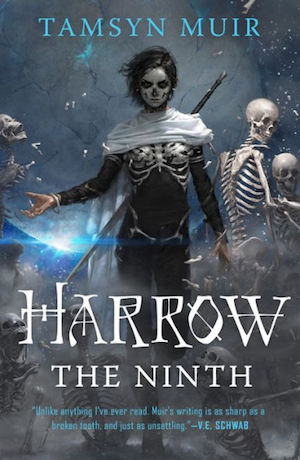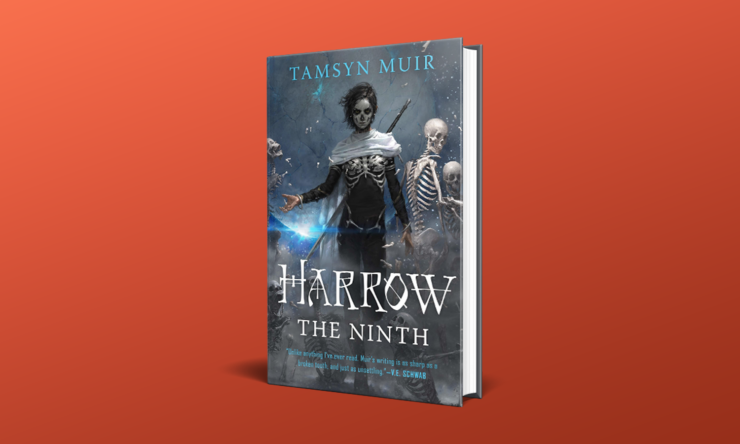At the conclusion of last year’s gruesomely fun Gideon the Ninth, Harrowhark Nonagesimus, last necromancer of the Ninth House…
[Warning: This review contains SPOILERS for both Gideon the Ninth and Harrow the Ninth.]
* * *
At the conclusion of last year’s gruesomely fun Gideon the Ninth, Harrowhark Nonagesimus, last necromancer of the Ninth House achieved victory over death and became one of the Emperor’s Lyctors at immense personal cost. Unfortunately for her, it turns out that those murderous trials were just the beginning. After being rescued from Canaan House by the Emperor’s shuttle, Harrow finds herself ensconced on God’s space station: another set of claustrophobic quarters full of dangerous companions. As an unwinnable war against the ghosts of dead planets bears down on her, she must fend off attempted murders, struggle against the betrayals of her own mind, and attempt to determine why her Lyctorhood doesn’t—quite—work right.
Before she dies a much more permanent death, and the Nine Houses with her.
Second books are tricky: a universally acknowledged truth. “Middle books” in trilogies are even more notoriously wonky—issues of pacing, development, and coherence tend to run rampant. I’m gentle with middle books, I’m gentle with second books. But as it turns out, I had no reason to soften my expectations for Harrow the Ninth, because Muir smashes through them with seemingly-effortless, somewhat deranged intensity. The flap copy calls it “a mind-twisting puzzle box of mystery, murder, magic, and mayhem,” and I couldn’t say it better myself. Harrow the Ninth works as an independent novel with a provocative, break-neck plot, but it also serves well as the gripping, rising-action-middle of a larger narrative.
Buy the Book


Harrow the Ninth
By layering mysteries on top of mysteries on top of immediate threats of violence, all trapped within the contained space of the Mithraeum, Muir drags the reader along at a constant what next, what next? pace. The chapter subheadings alone set up a great deal of tension—for example, the prologue is labelled “The Night Before the Emperor’s Murder.” Well, okay: how’d we get to that? Then the start of the first chapter (fourteen months before the Emperor’s murder) drives the nail home, because Harrow remembers assigning Ortus to be her cavalier on the trip to Canaan House.
Someone important is, we come to realize, missing from the narrative.
The structure of this novel and its central conceit make it literally impossible to discuss without SPOILERS. UNAVOIDABLE SPOILERS FOLLOW. I experienced a moment of consternation, as I write critical essays with spoilers generally, but try to hold some stuff back. That is not going to be the case, here, you’ve been warned.
Because the plot has multiple layers and all of them are fucking awesome. At the height of the twisty-turny-complicated ending I did need a second read to ensure I’d grasped the machinations and revelations… but they’re foreshadowed so thoroughly in the first book and throughout Harrow that, once I had the clues on lock, I wanted to do a slow-clap. Even small moments matter. A childhood fight between Gideon and Harrow led to the opening of the unopenable tomb—because it turns out that Gideon is the Emperor Undying’s genetic kid, thanks to a long-game assassination plot from his remaining Saints involving his semen extracted in a drunk immortal threesome, the Commander of the Blood of Eden armies, and a lost baby with golden eyes. Which led ultimately to Gideon’s blood under Harrow’s nails when she flees to the tomb to commit necromantic-magic-suicide. The tomb which apparently contains John the Emperor Undying’s cavalier in stasis? Oops.
And that’s just the large-scale, series plot. The actual central mystery of this book, why Harrow remembers everything that happened in the prior novel as involving Ortus, with Gideon forgotten and Harrow mad as a hatter, is deliciously convoluted. She wrote herself a set of letters, had Ianthe help her give herself brain surgery, and rewrote her memories to keep from digesting Gideon’s soul into her own—and that’s why she’s a shit Lyctor. But as it turns out, when we meet Original Gideon, perhaps there’s a way for them to coexist in the same body… except we’re not sure about how, either. Can’t wait to see where all that goes, frankly. For all the questions answered in Harrow, more and weirder questions—about the world, the Emperor, necromancy, and our protagonists—are proposed.
One reason the Locked Tomb books rocketed up to favorite-status for me is Muir’s ability to combine a wild pace and gonzo, almost-pulp sensibility with a seriously precise attention to detail on a prose level. These books are goofy, grim, and fun; they’re also deliberate, purposeful, and clever as hell. Muir hands us the clues we need from the first page, at the dramatis personae list with its typographical hints (‘Ortus’ in a different font, Harrow’s cavalier line blocked out). Another significant clue is that the narrator uses second person until Gideon emerges from her brain-box and shifts to the first person. On a second look, the reader might note the occasional crass phrases slipping through that are very Gideon and not very Harrow.
Harrow the Ninth also returns to the thematic center that I adored with Gideon: these young women might be absolute monsters to one another, but their circumstances shaped them into the kind of people capable of that violence. Muir doesn’t retreat from writing problematic queer women, and I use that word on purpose. While there’s an amount of policing and purity-harping present in a lot of online spaces for queer content, lesbian or f/f works tend to bear a heavier brunt—and all we have left that’s ‘okay’ to read and write is soft, fluff, no-conflict, no-trauma content. It brings me, as a grown adult, immense pleasure to read novels that deal seriously with questions of trauma, brutality, and how people work on their relationships when they, themselves, kind of suck as people.
There are a handful of lines near the end of the novel that emphasize this point, which I highlighted and underlined, that begin with the phrase: “The problem was that she had never been a child.” Both Gideon and Harrow had to grow up fast, becoming women as kids under the intense crucible of violence and pressure they lived in, and in so doing demolished each other over and over again. That matters, and it informs their whole relationship, but it’s also not entirely their fault. What matters is where they grow from there. Love that as a thematic argument.
On a lighter note, speaking of queer aggression and humor, Ianthe is a horrible delight. Her attraction to Harrow, despite knowing it will come to nothing, is really something. The interactions between her and Gideon-in-Harrow’s-body are some of the funniest moments in the novel, with a special nod to the fisting joke, thank you, Tamsyn Muir. Harrow the Ninth stays funny in a ‘laughing at the end of the world’ kind of way. Plus, a lot of referential internet humor that I actually suspect is narratively important (is this set 10,000 years in the future from now?). Oh, and then there’s the alternate-universe mind bubble Harrow has created for herself, what a genius, that cycles through a handful of fanfiction trope universes before solidifying. Gay brilliance, all of it.
I’ve restrained myself from speaking at length about the genetic inheritances (hah!) of the Locked Tomb books so far, but I adore when I can trace inspirations and sly nods to other material. Needs must be said: the Homestuck of it all is a winking ghost haunting Harrow the Ninth. The playful nods are many—the style of humor; the fleshy, grim, horny weirdness of bodies and violence; the fuckery with genetics, timelines, alternate universes; the “Saint of…” construction. It’s utterly different in the Locked Tomb series, of course. But as a fan of, well, fanfiction and Homestuck and the bizarro internet I too grew up on… these novels smack a whole lot of personal fun-buttons on top of how absolutely excellent they are on their own terms. (The barista meet-cute AU reference made me groan-laugh so hard.)
Harrow the Ninth is, without a doubt, a powerhouse second book both for Muir and for the Locked Tomb series as a whole. Rather than crumbling under the pressure of the debut, this book doubles down on structural cleverness and total commitment to its (sexy, weird) necromantic aesthetic. I read the damn thing in almost one sitting, then read it again. And in pandemic-hell, reading one book a single time has presented a challenge. To have the desire to immediately re-read is the highest praise I can possibly offer. Harrow has the frenetic energy and grim humor I need at the moment—it’s gay, it’s rambunctiously violent, and it’s got a real heart beating under all of that.
And that last chapter, y’all. The last chapter, again. What’s next?
Harrow the Ninth is available from Tordotcom Publishing.
Lee Mandelo is a writer, critic, and editor whose primary fields of interest are speculative fiction and queer literature, especially when the two coincide. They have two books out, Beyond Binary: Genderqueer and Sexually Fluid Speculative Fiction and We Wuz Pushed: On Joanna Russ and Radical Truth-telling, and in the past have edited for publications like Strange Horizons Magazine. Other work has been featured in magazines such as Stone Telling, Clarkesworld, Apex, and Ideomancer.










